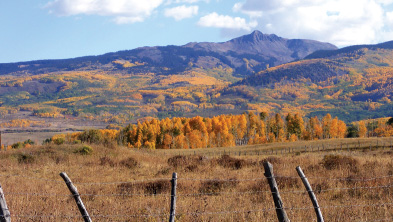“Wood is good” is one of those statements that may arouse different emotions in different people. For some like me, wood comes from trees that our Creator made for man to use. Wood is one product of trees that provides a roof over my head, warmth in the winter, furniture for my house, paper to write letters to the editor on, and a myriad of products I use in everyday life.
Other people see trees, not as wood to be used, but only as ethereal beauty to be worshipped, not to be touched by man, assuming the trees have been and always will be as they are today. The understanding that our Creator provided the trees for man’s use, and charged him with the tending, cultivating, and care of them, has been lost in the minds of so many. This has resulted in political efforts to irresponsibly “protect” the forests and trees from logging, the forage from grazing, and the land from mining and drilling. This is totally contrary to our Creator’s charge to use and care for the land and resources.

Aspen on the southeast side of Caviness
Mountain showing differing clones. Photo by Dexter Gill.
Question! Look around you and tell me where all that “stuff ” you have came from, and I don’t mean Home Depot, Walmart or China. I would challenge you to find anything that does not come from the Earth via logging, mining and drilling, or grazing. For starters, look at your “smart phone” – what is it made out of ? Search it out! Now are you sure you want to stop drilling and mining? What about wood? You can’t go through a day without using wood and not knowing it. Have you heard of methanol, a.k.a. methyl alcohol? Search out what it is a necessary ingredient in, then search where it comes from. Spoiler alert, it comes from wood!
My point is, our lives today are fully dependent upon mining, drilling and harvesting wood and other vegetation. Even in the Stone Age, they did those same activities, just not as well refined as we do today. Yet we hear the cries to stop mining, drilling and harvesting of wood, clearly expressing their abysmal ignorance.
Now getting back to good ole wood, we have to dispel the misconception that trees never change or die. Well, they do die, some sooner than others. In June, we talked about repurposing trees, and this month let’s look at one local species of tree that is being repurposed while helping to regenerate and “save” the species for future generations. You have heard of the concern that the quaking aspen that turn our forests a brilliant yellow each fall, are dying off. The aspen is naturally a rather short-lived tree that is also sensitive to weather and a variety of diseases, giving it a life span of 40 to 150+ years. They most commonly reproduce on areas that have been opened up from wildfires or logging to act as a nurse crop to protect the soil while longer-lived and slower-growing pines, firs, or spruce trees become established. They grow in even-aged stands called “clones,” as their roots are mostly all interconnected as “suckers” from a parent plant. As the clone ages and begins to die, harvesting the clone acts to stimulate the roots to regenerate itself, sending up new young shoots which wildlife and livestock can benefit from as the clone grows. Decision time: do we let nature do its thing as the trees die and burn up or do we harvest and “repurpose” the trees for man’s benefit as well as the forest environment for the future?
If the aspen clone is harvested, what is the wood to be used for? The wood is actually quite versatile and it machines well and can be used for furniture parts, toys, kitchen utensils, and even sauna laths. Locally, we have two forest “surgical” operations that are providing employment and local economic health, while improving the forest’s health. For starters, Aspen Wall Wood produces interior wood paneling that is literally a one-of-a-kind! The planer shavings are used for livestock bedding. The Mancos operation produces Excelsior for water cooler pads and environmental wattle bags for landscaping and erosion control along highway drainages. I’m sure you have seen those along the highways, they look like giant sausages lying across the drainage. Both mill locations make firewood available from trim ends. In the past, I remember topping the hill going down into Mancos, seeing the Diamond Match plant where they used aspen to produce the ideal match stick.
Our newest operation, Ironwood Group, is producing aspen wood veneer for use in plywood and other veneer project needs. Posts are available from the lathe cores and firewood from the trim ends of logs. Goals in all operations are to make beneficial use of the resources, and not waste any. We can save the aspen trees through forest “surgery” and make some “good wood” uses from what would otherwise become smoke and ash. Be sure to shop and support our local “wood is good” businesses.
Next month we will look at another of our tree species and what is and could be done to use it beneficially rather than paying taxes to burn it to produce smoke and ash. The economic, medical and spiritual health of the county and people depends upon our ability to work together to produce beneficial results from the resources our Creator has provided. We just need to be innovative, eliminate roadblocks and provide more opportunities for our people to work together to build our lives in Freedom and Liberty.
Dexter Gill is a retired forest manager who worked for private industry, three Western state forestry agencies, and the Navajo Nation forestry department. He writes from Lewis, Colo.

